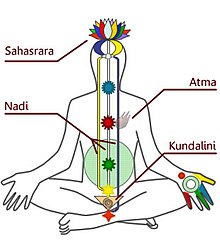Shaktipat
The spiritual teacher Meher Baba
emphasized the need for a master when actively trying to awaken the
kundalini: "Kundalini is a latent power in the higher body. When
awakened it pierces through six chakras or functional centres and
activates them. Without a master, awakening of the kundalini cannot take
any one very far on the Path; and such indiscriminate or premature
awakening is fraught with dangers of self-deception as well as misuse of
powers. The kundalini enables man consciously to cross the lower planes
and it ultimately merges into the universal cosmic power of which it is
a part, and which also is at times described as kundalini....The
important point is that the awakened kundalini is helpful only up to a
certain degree, after which it cannot ensure further progress. It cannot
dispense with the need for the grace of a Perfect Master."
Kundalini awakening while prepared or unprepared
The experience of kundalini awakening can happen when one is either prepared or unprepared.
Preparedness
According to Hindu tradition, in order to be able to integrate this
spiritual energy, a period of careful purification and strengthening of
the body and nervous system is usually required beforehand. Yoga and Tantra propose that kundalini energy can be "awakened" by a guru (teacher), but body and spirit must be prepared by yogic austerities such as pranayama, or breath control, physical exercises, visualization, and chanting. Patañjali
emphasised a firm ethical and moral foundation to ensure the aspirant
is comfortable with a reasonable degree of discipline and has a serious
intention to awaken their full potential. The student is advised to
follow the path in an openhearted manner.
Unpreparedness
The kundalini can also awaken spontaneously, for no obvious reason or
triggered by intense personal experiences such as accidents, near death
experiences, childbirth, emotional trauma, extreme mental stress, and
so on. Some sources attribute spontaneous awakenings to the "grace of
God", or possibly to spiritual practice in past lives.
A spontaneous awakening in one who is unprepared or without the
assistance of a good teacher can result in an experience which has been
termed as "kundalini crisis", "spiritual emergency" or "kundalini syndrome".
The symptoms are said to resemble those of kundalini awakening but are
experienced as unpleasant, overwhelming or out of control. Unpleasant
side effects are said to occur when the practitioner has not approached
kundalini with due respect and in a narrow egotistical manner. Kundalini
has been described as a highly creative intelligence which dwarfs our
own. Kundalini awakening therefore requires surrender; it is not an
energy which can be manipulated by the ego.
